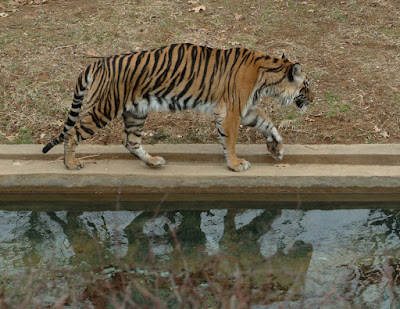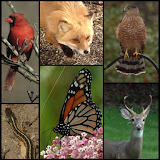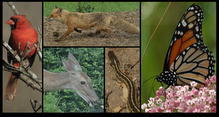Here is a general update on happenings around the Colvin Run Habitat:
>The ill or injured red-tailed fox has not been observed this week.
 >Beginning in mid-May, chipmunks began being observed. First on a one by one basis. Now as you can see from the photo, they show up several at a time and are active all day.
>Beginning in mid-May, chipmunks began being observed. First on a one by one basis. Now as you can see from the photo, they show up several at a time and are active all day.
 >Sadly, one of the chipmunks drown in the water tub that the birds, chipmunks, and squirrels drink from.
>Sadly, one of the chipmunks drown in the water tub that the birds, chipmunks, and squirrels drink from.
 >For the first time in at least a month, a hawk was observed hunting in the Habitat. Per the standard practice of the Cooper's Hawk, this hawk was seen dropping from one of the border trees down and past the sunflower seed feeder, and then through the dense oak and Bradford pear trees. This hawk was crow-sized, dark brown, tail dark with darker stripes. Most likely given the size, color, and fly-over of the feeder and through the trees, I believe it was a Cooper's Hawk. Sorry no photos as I observed this hawk while looking out the bathroom window while shaving.
>For the first time in at least a month, a hawk was observed hunting in the Habitat. Per the standard practice of the Cooper's Hawk, this hawk was seen dropping from one of the border trees down and past the sunflower seed feeder, and then through the dense oak and Bradford pear trees. This hawk was crow-sized, dark brown, tail dark with darker stripes. Most likely given the size, color, and fly-over of the feeder and through the trees, I believe it was a Cooper's Hawk. Sorry no photos as I observed this hawk while looking out the bathroom window while shaving.
>Bird parents are bringing their young to the feeders. Again sorry that I have no good photos. While the young are identified sometimes by coloring and perhaps smaller size, my identification is by behavior. First, the young are only too eager to take food from the parent - even if it is feeder seed. Second, the young have a real tough time landing on the feeders, especially the feeder mounted on the window. The young flutter around the feeder and sometimes stumble into the window or land on the storm windows. Clearly, the young do not yet have complete flight control.
>Although the hummingbirds were observed in May, the hummers have been noticeably absent during the last few weeks.
>Also, the flicker woodpecker is seen maybe once a month. Last year this time, the flicker was a common visitor.
>The red-bellied woodpecker is observed every three weeks.
>The box turtle was observed early one morning in the grass on a path similar to last year.
>In an unbelievably rare event, I opened the garage door one morning to see a pileated woodpecker at the foot of a tree about 20 feet away. Amazingly, this normally very shy woodpecker continued to feed on the driveway tree (insects most likely). Then he flew away, but was heard for the next few minutes giving his unique call from the adjacent woods.

 To prevent rioting in the Habitat, the Colvin Run Habitat Blog paid top dollar to the paparazzi that frequent the area east of the Bridge that slopes to the Park for this second photo. While not the same as an in-rodent visit, perhaps this photo of Woodchuck will ensure peace in the Habitat until the book is finally published.
To prevent rioting in the Habitat, the Colvin Run Habitat Blog paid top dollar to the paparazzi that frequent the area east of the Bridge that slopes to the Park for this second photo. While not the same as an in-rodent visit, perhaps this photo of Woodchuck will ensure peace in the Habitat until the book is finally published.
















































